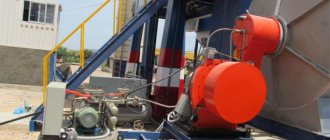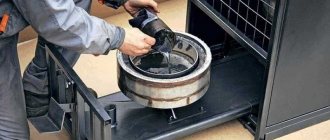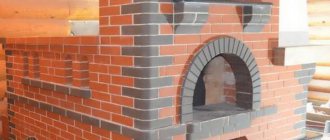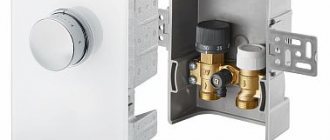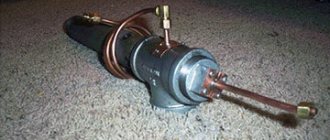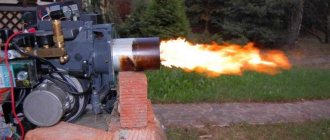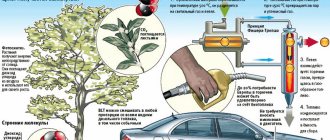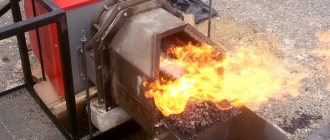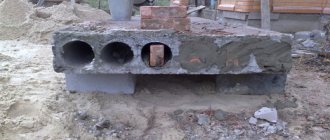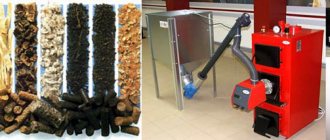Home / Burners for boilers
Back
Published: 06/25/2020
Reading time: 5 min
0
1335
A pellet burner is a modern energy-efficient device designed to use a special fuel for solid fuel boilers - pellets.
The main advantages of this type of boiler equipment are considered to be the high efficiency of the heating unit due to the complete combustion of pellets and the possibility of 100% automation of the combustion process using innovative diagnostic and control tools.
Modern household welding and plumbing tools allow the home craftsman to make a pellet burner with his own hands.
- 1 Design and principle of operation of a pellet burner 1.1 Gravity burners
- 2.1 Creating a drawing of a pellet burner with dimensions
About the pellet burner
A pellet burner is a special heating device that produces heat by burning pellets or fuel granules in a boiler. In some cases, these burners use unnecessary dry grain.
There are manual and automatic burners; in automatic burners, fuel is supplied to the combustion hopper using a special auger, and the entire process is controlled by sensors, due to which the device requires minimal control from the user. Pellet burners have found their use not only in everyday life, but also in industry. They are used for space heating, water heating and to meet a number of other needs.
Pellets, or fuel granules, are a special solid fuel that is obtained from wood or agricultural waste by pressing and granulating under high temperatures.
Pellets are an environmentally friendly type of fuel, since when they are burned, the same amount of carbon dioxide is released into the atmosphere as is formed during the natural decomposition of wood
In countries where agriculture and the woodworking industry occupy leading positions, the cost of pellet fuel is much lower than that of coal. The only exceptions are those regions in close proximity to which coal mining enterprises are located.
When burning pellets, hazardous fumes are not released, as happens when burning liquid fuel.
Broken pin (shear bolt): causes.
A common reason for the boiler to stop working is the pin (shear bolt) that connects the engine to the auger breaks. Below are possible reasons for this failure:
- Fuel of non-recommended fraction
- Foreign bodies in fuel (bolt, stone, pieces of wire)
- Deposits (carbon deposits) in a retort-type burner - carbon deposits reduce the diameter of the channel for fuel supply to the burner and increase the resistance of the screw. The problem is easily identified: when carbon deposits are deposited on the retort elbow, the “crunching” sound when fuel is supplied to the burner becomes louder. Once a year, before the start of the heating season, clean the fuel supply elbow to the burner. If the boiler runs on pellets, it is better to repeat the procedure during the season - when using pellets, carbon deposits form faster.
- Damage to the auger. Over time, the auger turns wear out mechanically or are destroyed by sulfur contained in the fuel. In places of wear, the auger does not move fuel but grinds it. Sawdust or coal chips accumulate in the feed tube, increasing the resistance of the auger. The wear rate of the auger depends on the humidity of the fuel used, the sulfur content in the fuel and the location of the boiler room (in a damp basement and without ventilation, the service life of the equipment is reduced).
- Incorrect installation of the boiler (the adjustable foot of the fuel tank is used to adjust the height and leveling of the boiler supply system).
| IMPORTANT! When transporting the boiler, do not lift the structure by the screw feeder pipe: if the load is distributed incorrectly, the pipe is deformed and the geometry of the feed system is disrupted. The result: additional noise when the auger rotates, its premature wear and constant pin failures. |
Principle of operation
All pellet installations that can be purchased in the store are equipped with additional components:
- Auger – supplies fuel from the bunker to the combustion chamber;
- Controllers for automating the work process;
- Bunker – the place where the fuel is located before being supplied to the combustion chamber;
- A lambda probe is a special sensor that monitors the oxygen content in smoke chambers and independently controls the fuel combustion process depending on conditions.
The pellet burner must be protected with a plastic corrugated pipe. It acts as a fuse when reverse draft occurs. If the fire begins to move towards the bunker, the pipe burns out, preventing the flame from spreading.
Additionally, a fan is used, which enhances the combustion of pellets by pumping air, as well as a thermoelectric heater, which allows the fuel to be ignited without human intervention.
In automated devices, pellets are fed into the combustion chamber automatically; a person is only required to monitor the amount of fuel in the bunker. The need to supply fuel to the combustion chamber is determined using temperature sensors (they can monitor the air temperature in the room, the water temperature, or any other environmental indicators depending on the operating mode of the equipment).
The required temperature of the coolant is set by the user, all further increases and decreases are controlled using automated equipment. As soon as the temperature reaches the set level, the burner begins to operate in standby mode (the pellets do not go out, they begin to smolder). If the temperature, on the contrary, drops, the controller activates the built-in fan. Under the influence of air, the pellets flare up and the burner goes into operating mode. If during downtime the pellets go out for any reason, the heating element is activated, which re-ignites.
Design and principle of operation
A typical pellet burner is both simple and complex at the same time. The components of the devices are:
- tray for storing fuel;
- fryer;
- fan;
- kindling device.
A typical burner that runs on pellets is initially supplied in most cases with a full set of necessary parts and accessories. In addition to the automation (controller), it includes an auger that feeds the pellets themselves. There must be a lambda probe. This part measures the remaining air volume and adjusts combustion accordingly. The fuel tank is usually called a bunker.
A plastic corrugation can be placed between the auger and the burner. Its main function is to prevent the spread of flame when backdraft occurs. The key components of a pellet burner will also be the electric heater (which works automatically) and the fan, which is located at the bottom or rear of the device. Since fuel is supplied to the combustion chamber automatically, the labor intensity of the work is significantly reduced. Homemade modifications of burners mainly use an Arduino controller.
In conjunction with it must be:
- display;
- digital heating sensor;
- from 4 to 6 buttons;
- several relays and transistors.
As for gearboxes, they, of course, are not used (after all, this is not gas equipment, after all). But geared motors are quite useful
Most manufacturers emphasize that such units are universal, that is, they are suitable for the vast majority of models of burner systems with and without air supply available on the market. Device power is usually 25, 40 or 60 W
Device
Any burner has one goal - creating a powerful flame to heat the air or water jacket of the boiler. At the same time, the combustion power itself can be adjusted independently.
A pellet burner has similar goals. The device is a wind tunnel into which solid fuel is supplied and air is pumped for combustion. Fuel is supplied to the pipe using a special screw-type conveyor. The fuel itself is located in the loading hopper before combustion. The bunker can have a different volume, and it depends on the volume how long the burner can burn on its own without human intervention (adding fuel).
Pellet burner structure: 1 - The pellet enters the burner under the influence of gravity; 2 - Air enters the burner due to the vacuum created by the draft of the chimney; 3 - Pellet combustion occurs in the combustion chamber, which is called the “basket”; 4 - Due to the high temperature, thermal decomposition of wood occurs in the basket, which forms a flow of flammable gases; 5 - A secondary air flow passes under the basket; 6 - In the burner nozzle, the flow of combustible gases and secondary air mixes, forming a torch; 7 - Solid combustion products are ejected from the burner into the ash pan of the boiler or furnace by a stream of secondary air; 8 - Ventilation of the supply channel does not allow hot gases to diffuse up the channel and destroy the pellets, ensuring a stable supply of pellets.
Air is forced into the combustion zone by means of a fan.
The combustion chamber in the burner can be round or rectangular. Round burners are the most common due to their ease of manufacture. A pipe connection is attached to the outside of the combustion chamber, through which fuel is supplied from the conveyor.
The design also includes an ash pit in which combustion waste accumulates. During the combustion of pellets, a little ash is formed, so you need to clean the ash pan no more than once a week when the burner is actively used.
What to do to avoid fire?
- Ensure constant boiler draft, hermetically seal the fuel tank and monitor the condition of the fuel tank lid gasket.
- Check the cleanliness of the channel and the air mixer chamber: dust or ash enters the mixing chamber through the blowing nozzles and over time clogs the air supply channel of the fan - as a result, the fuel burns unevenly and the efficiency of the boiler decreases.
- Adjust the fuel supply parameters; if the supply speed is slower than necessary and the air supply to the burner is incorrectly configured, more intense fuel combustion occurs. The result is that combustion begins to move down the burner and goes into the fuel supply pipe.
- The burner metal also heats up and heats the feed tube, resulting in a false alarm indicating reverse heat flow. To avoid false alarms, install a special non-flammable gasket separating the burner and the pipe - the gasket will not allow the temperature of the heated burner to be transferred to the feeder pipe.
Torch pellet burner: manufacturing
Unlike a gravity burner, a flare burner is equipped with a screw conveyor, a fan and an electronic controller, which significantly increases the material costs of manufacturing the unit. Despite this, this design has become widespread due to the following advantages:
- High performance;
- Unpretentiousness to the quality of the granules used;
- Possibility of working in autonomous mode, while the duration of operation is determined solely by the capacity of the fuel bunker;
- High degree of fire safety.
To make a fecal pellet burner with your own hands, you will need to purchase:
- Low-speed electric motor (or two, depending on the design of the feed mechanism);
- A fan that will provide forced air supply to the combustion chamber;
- An electronic controller that monitors changes in coolant temperature and sends corresponding signals to the actuators of the device.
As for the manufacturing process itself, it is much more complicated than the manufacturing process of a gravity burner, since it becomes necessary to install temperature sensors and connect an electronic control system. The materials for manufacturing the unit do not differ from the previous version.
Development of the project and drawings
You can make a pellet burner with your own hands only if you correctly develop a preliminary project, prepare the tools for work and the required materials. When making a homemade pellet burner, the drawings must necessarily show all the details and structural elements, including the combustion chamber, which is represented by a pipe with a square or round cross-section, as well as a fan, a fuel loading hopper and a screw conveyor.
The frequency of maintenance of boiler equipment that operates in autonomous mode will depend directly on the size of the installed bunker for loading fuel.
See also: options for modern stoves.
The electronic control panel independently controls the operation of the fan and all data on the air supply intensity, which has a direct impact on the combustion rate of the pellets in the firebox.
When drawing up the project, it is necessary to take into account that the operation of the main structural elements, which are represented by a screw, a fan and an electronic control unit, is ensured using electricity, therefore this equipment is volatile.
Retort pellet burner: manufacturing
The supply of granular fuel in such devices, as well as in flare devices, is carried out using a screw conveyor. The difference is that the granules are fed from below. The air required for combustion is forced through special holes in the walls of the retort. For the effective operation of such a device, a controller is required that promptly responds to changes in coolant temperature and makes the necessary adjustments to the operation of the auger and fan.
Unlike flare devices, the flame in a retort pellet burner is directed upward, so the design of the heat exchanger for these units is very different. The disadvantages of retort systems include:
- Possibility of frequent clogging of the air duct openings, leading to attenuation of the device;
- The need to manually clean the retort from combustion products and granulated fuel residues;
- No gaps in the supply of granules. If reverse draft occurs, the possibility of ignition of the pellets in the bunker remains.
Heat-resistant steel and cast iron can be used as the material for the bowl. In some models, the retort can be made of ceramic concrete or fireclay.
The complexity of manufacturing such a device at home is quite high, since in addition to plumbing and welding work, skills in connecting electronic control systems will be required.
Pellet burner with forced intake
This device is one of the best when it comes to fire safety in the house. The representative is the Teplodar pellet burner. The downside is the high cost of the burners, reaching $3000. The burner has several mechanisms that ensure the supply of pellets inside. One mechanism operates the auger, and the other operates the pneumatic system. The safety of the product lies in the fact that the channel runs from bottom to top (pellets move along it). The flame will move in the opposite direction, so it will not get into the bunker.
Note! Fuel is supplied in portions and does not remain in the channel along which they move.
Another advantage is that designs with a pneumatic system are equipped with large hoppers. They can be downloaded once a month.
As for screw feed mechanisms, they have two main units. The first is the auger. He takes the pellets from the hopper, pouring them into another mechanism. Another auger lifts them directly into the burner. Even so, a fire is possible, since the fuel remains along the entire length of the auger. For protection, engineers create another unit made of material suitable for the burner. It melts and self-extinguishes. This is a kind of fuse that cuts off the fire.
The disadvantage of such mechanisms is that they are dependent on electricity. Without it, the supply of pellets stops, and what’s worse, the heating system may suffer. Power must be supplied to two electric motors. In the case when the electricity is stable and does not disappear, you can purchase additional air inflating. With it, the combustion of pellets will be better, as will the efficiency.
Do-it-yourself automation for a pellet burner
The most difficult stage in the manufacture of a pellet burner is the manufacture and installation of electronic control modules. If we consider this issue from a theoretical point of view, if you have special knowledge, you can make a controller yourself, but in practice this is almost impossible. In addition, the cost of components will reduce cost savings to a minimum, and the result may be very questionable. Therefore, even if you make your own burners, controller, sensors and other automation, it is better to purchase them in a specialized store.
For efficient operation of the burner, the automation must provide:
- Dosage of pellet supply and control of the screw conveyor;
- Automatic ignition and extinguishing;
- Adjusting the air supply by changing the fan speed;
- Estimation of the amount of coolant in the heating circuit;
- Control of coolant temperature in the boiler water jacket;
- Assessment of draft parameters in the chimney.
Failure to comply with even one of these conditions can lead to failure of not only the heating boiler, but also the entire heating system.
Making a pellet burner is a labor-intensive and responsible process, however, if you have the necessary knowledge and equipment, it is quite possible to make such a device yourself. Particular attention should be paid to the selection of parameters and installation of electronic control systems; the efficiency of the boiler will depend on the correctness of their operation.
Gravity pellet burners
Such designs are easier to handle. Their great advantage is their ability to operate even without power supply. The principle of operation of the device is to pour pallets into the firebox under their own weight. The behemoth pellet burner and the pelletron pellet burner are prominent representatives of gravity products. You can put them into operation by adjusting the supply damper and the draft regulator on the chimney. The disadvantage of the design is that the pellets in the bunker can ignite.
To solve the fire hazard issue, manufacturers install thermal dampers on burners of this type. When the flame breaks out from the hearth and moves towards the bunker, a special gateway comes into play. It is heat activated. The airlock serves as a fire barrier. Another protection option is a double grate. This is a simple mechanism consisting of two parts. The upper one approaches the pellets and picks up a certain amount of them. Then the part moves towards the flame. The second part begins to dump ash into the receiver.
Advice! For a double grate it is also recommended to install a fire sluice. The mechanism may jam, and the fire will penetrate the pellets loaded into the hopper.
Making a burner with your own hands
How to make a pellet burner? The combustion chamber is made of steel pipe. Wall thickness – 4 mm no less. The steel is heat-resistant and can withstand high temperatures. Attachment to the boiler unit body is carried out using a flange plate. For manufacturing you will need 3 mm steel. It is better to buy a conveyor for feeding pellets or use an auger.
To rotate the mechanism, you need bearings, a low-speed motor (electric) and a gearbox. A fan for supplying air can be purchased at the store. It is fixed on the plastic, in which the place has already been prepared. The plate is made based on the drawing. The configuration depends on the boiler door itself. A drawing of the burner can be seen in this photo.
A mandatory step is to adjust the amount of incoming pellets and air. Without this, the device will work unstably or constantly at full power. To change the intensity of the fan and auger, you can install a manual regulator. In this case, you will have to constantly monitor and adjust the burner, taking into account the temperature of the coolant and air.
It is important that during various work processes, fuel and air are correctly selected. Only then will the torch be even and stable. To do this, you cannot do without an automated device. You will need a control unit. The burner controller has free control contacts, to which the electric motor from the screw and fan is connected.
To automate the ignition of pellets and control the flame, you cannot do without a photosensor and an electric incandescent element. A photo sensor monitors the appearance of a stable flame and notifies the controller. It will turn off the filament element. But an incandescent element is needed to ignite the pellets. The supply pipe is equipped with a filling sensor. It stops feeding pellets when the auger and top pipe are full.
general description
As a rule, a standard pellet burner is sold by manufacturers already equipped with various accessories. Most often, the following items are included in the package:
- controller for automation of work;
- auger for feeding pellets;
- lambda probe, which measures the residual air volume and automatically regulates combustion;
- bunker fuel tank.
In some cases, a plastic corrugation is installed in the area from the auger to the burner, which prevents the spread of flame when reverse draft occurs. The main components of the burner are also:
- electric heating element, which is involved in automatic ignition;
- fan for air supply, located at the bottom of the device or at the back of the boiler, controlled using a controller.
In this video we will learn how to make a pellet burner with your own hands:
Automated supply of fuel from the bunker to the furnace occurs without human intervention. The pellets are fed using an electrically driven screw device, and the process is additionally checked by a controller with thermal sensors and an indication system that displays the operation of the burner itself.
The control circuit for the coolant temperature mode is simple. When the set temperature is reached, the burner, using the controller, goes into standby mode with prolonged smoldering of the fuel. Then, when the coolant cools down to a certain temperature, the sensor transmits a signal to start the fan, this causes the fuel to ignite and transfer the device to normal operation. A heating element is often used for ignition.
The efficiency of the burner will depend on the speed at which fuel is poured into the firebox and the volume of the fuel itself, therefore only the correct setting of all indicators contributes to the optimal effect of the operation of this equipment.
Description of operating modes
The very principle of operation of a pellet burner is as follows: a portion of fuel enters the chamber, it is ignited and the minimum air supply is turned on. As the fuel burns and the chamber warms up, more air is forced in. As a result, a stable, even flame appears, heating the heat exchanger with water. In factory burner devices, the process is fully automated, ignition is provided by an electric incandescent element, and its operation is controlled by a photosensor. The amount of air and pellets supplied to the chamber is regulated by an electronic unit, receiving signals from temperature and pressure sensors. A diagram of a pellet burner will help you understand how the device works.
Fuel in the form of wood pellets or seed husks can be supplied to the pellet burner auger in various ways:
- The traditional method is to supply pellets from a separate large hopper so that its capacity is enough for at least 7 days of operation of the boiler, which needs to be cleaned once a week. From the bunker, the fuel is moved to the burner device by an additional screw conveyor of the required length.
- A DIY gravity pellet burner can be equipped with a simpler fuel supply. In it, husks and granules are poured under their own weight into an auger from a hopper installed directly above the burner device, which delivers the required amount into the combustion chamber. Then the power reserve of the boiler will be from 1 to 3 days, depending on the intensity of work.
Types of burners
Today, there are several types of pellet burners that can be installed inside a heating boiler:
- Torch typeused when heating a small room, and was originally used for burning grain crops. The advantages are represented by very compact dimensions for small combustion chambers, simple design and reliability during operation, as well as minor requirements for the quality characteristics of the fuel. The main disadvantages can be considered insufficient power indicators, as well as local heating under the influence of a horizontally directed flame.
- Volumetric or stoker type , with large dimensions and a rather complex design. During the installation process, the installation angle must be correctly determined, which will prevent the formation of a large amount of wood ash. It is equally important to correctly install the auger for the fuel supply. The disadvantages include very high requirements for the quality of the fuel used.
- The “Fireplace” burner type is intended for pellet fireplaces and some types of modern pyrolysis boilers. The combustion process takes place in the bowl, and air masses are supplied from below. Fuel in the form of pellets is poured from above.
It should be remembered that the “fireplace” design is extremely rarely used in industrial pellet burners, which is due to the size and the need to perform very precise adjustments of the equipment being used.
Currently, flare-type pellet burners widely use computer control, which makes it possible to adjust the fuel supply speed, as well as easily regulate such indicators as air flow power, speed and frequency of cleaning the device.
Automation tools
The ratio of air and fuel supply to the combustion chamber must be adjusted, otherwise the operation of the burner device will be unstable or at maximum power all the time. The easiest way to change the speed of the auger and fan motors is to install a simple manual regulator. But then inconveniences will arise in the form of constant supervision and adjustment of the heating unit depending on the temperature of the coolant and the surrounding air. Self-adjusting a pellet burner involves selecting the ratio of air and fuel in different operating modes, at which the flame will be even and stable. Device automation will help achieve this.
Pellet burner with hopper
First you will need to buy an electronic control unit. If your boiler is already equipped with one, then explore the possibility of using it. As a rule, controllers from leading manufacturers have free control contacts to which fan and auger motors can be connected. In this case, based on sensor signals, the controller will increase or decrease the supply of pellets and regulate the fan speed.
In terms of ignition and flame control, a homemade pellet burner made by yourself can also be automated. You need to buy an electric incandescent element and a photosensor. The first will turn on at the very beginning, igniting the fuel, and the second, when a stable flame appears, will signal this to the controller, which will turn off the glow element.
A filling sensor can be installed on the supply pipe; its role is to send an impulse to the electronic unit when the auger and the upper pipe are filled with fuel to stop the supply of pellets. All these automation means allow you to effectively burn pellets and create a certain comfort when servicing the heating installation. However, there are some disadvantages here:
- A homemade pellet burner cannot be connected to every controller.
- The existing electronic unit of the heating unit is often not suitable for working with ignition and burner control devices, then you will have to buy a new one.
- The cost of manufacturing the device increases.
Good article on the topic: How to make a sawdust boiler
Preparatory activities
Before you make a homemade pellet burner with your own hands, you need to decide on the heating area of the room, this will make it possible to accurately calculate the power of the boiler equipment.
The main factors that are certainly taken into account during the calculation:
- height and size of the heated room;
- average temperature in your area;
- wall material;
- number of window and door openings.
Taking into account the reference literature, it is necessary to determine the thermal resistance coefficients of materials, and then perform heat loss calculations. The power of boiler equipment must be approximately 20 percent greater than heat losses.
If you need to independently calculate the boiler power indicators, you can use a special calculator. In this case, the error in the calculations made will be insignificant.
How to choose a pellet burner
When choosing a burner device, pay attention to technical characteristics, productivity, degree of automation, etc. It would be a good idea to study the reviews of the owners, and you should take into account not only positive, but also negative comments.
The following recommendations will help you make the right choice:
- Manufacturer - burner devices from European manufacturers are approximately 2 times more expensive than their Russian counterparts. The highest quality products are offered by Kiturami, Ferroli and the German concerns VIESSMANN and BUDERUS. Domestic-made burners are unpretentious in terms of pellet quality and are fully adapted to Russian operating realities. Products are offered by the following manufacturers: Pelletron, Teplodar, Svetlodar and Obshchemmash.
- Automation – there is a certain degree of automation in each burner, but for ease of operation, it is optimal to use systems with a self-cleaning function and an installed flame attenuation controller. A burner with automatic cleaning (as in Svetlobor models) can operate without human intervention for about a month.
- Type of ignition - mechanical and electrical ignition of pellets is used. In the first case, when ignition is carried out, the owner will need to press the button several times and hold it until the boiler starts working. In the second case, simply press the start key. The automation independently controls the combustion process and automatically ignites the pellets if the flame dies out.
A high-quality burner allows you to save significantly by reducing the cost of pellets and optimizing the combustion process. Choosing the right model is quite simple, thanks to the large range of products from domestic and foreign manufacturers.
Review of popular domestic manufacturers
The products of the domestic brand PELLETRON are distinguished by their simplest design and low cost. They are absolutely independent of electricity and work perfectly in the presence of good natural draft. That is, to achieve maximum power of the burner device, the vacuum in the boiler furnace must be 20 Pa, which can only be ensured by a properly constructed chimney. An atmospheric pellet burner for a solid fuel boiler Pelletron-15 can be installed on almost any unit with your own hands; you just need to cut a rectangular opening in the loading door. The product is inserted into it and secured to the door with screws from the inside; grates and other parts are removed from the firebox space. They can be returned to their place at any time if necessary.
Thus, the advantages of the model also include low weight and ease of installation. However, there are also disadvantages:
- There is no automatic ignition system; for this you need to use a special cylinder with flammable liquid and a nozzle.
- Power is adjusted manually.
- High demands on the natural draft force of the chimney.
- The power of the product is limited to 15 kW; the design of the Pelletron-15 pellet burner using conventional draft does not allow its use in more powerful boilers.
- The manufacturer requires cleaning the chamber and grilles once a day.
Pellet burner apg 25 teplodar
Another product from a domestic manufacturer is the APG 25 Teplodar pellet burner. From the name you can judge the power of the device - 25 kW, the control range is from 5 to 25 kW. The principle of operation is a torch burner device with forced pressurization and automatic supply of pellets from the hopper. Ignition is carried out by an incandescent element, the process is completely controlled by the controller.
Brief overview of imported products
A foreign alternative to domestic products is the Kiturami pellet burner , the list of its characteristics is as follows:
- power range – from 8 to 33 kW;
- Product efficiency is up to 95%, the overall efficiency value depends on the design of the boiler;
- remote controller;
- sensors for temperature, water level, overheating, overflow of auger with granules;
- self-cleaning grate.
The disadvantages of this device are its high cost and dependence on the reliability of the power supply. Otherwise, the product is quite reliable and does not cause any complaints; it is equipped with DRAGON KRP solid fuel installations.
Ferroli pellet burner
The Ferroli Sun P7 and Sun P12 pellet burner, which is installed on solid fuel units BUDERUS and SFL, is no less highly reliable. Maximum power is 34 and 55 kW, respectively, the set of options is the same as that of the previous manufacturer. The fan is a centrifugal type that provides a sufficient amount of air.
The imported Pelltech pellet burner has a wide range of available capacities, from 20 kW (Pelltech PV-20) to 1 MW (Pelltech PV-1000). It works well in conjunction with VIESSMANN boilers; the latter’s delivery package includes, as an option, a gas cleaning unit with a smoke exhauster; it is needed for installations with a power of over 200 kW.
Advantages and disadvantages
The equipment has a number of advantages:
- Pellets are a safe fuel compared to gas and electricity;
- Allows you to significantly reduce space heating costs compared to using electric boilers. At the same time, pellet installations are more expensive than gas equipment, but do not forget that it is not always possible to supply gas and purchase gas cylinders;
- Homemade installations guarantee high efficiency - 95%. Some store installations are over 97%;
- They are used not only for heating the room, but also for producing hot water;
- There are no rules for transporting and storing fuel. When near a person, pellets do not cause allergic reactions, and there are no toxic fumes when burning;
- Fuel is available for purchase. Equipment owners complained about the lack of fuel and the need to prepare a supply of pellets from the winter when the devices appeared; now there is no need to store a large volume of pellets at home; if necessary, they can be bought everywhere;
- The price of pellets is on average at the same level, unlike gas and electricity, the tariffs for which periodically experience seasonal fluctuations;
- Installation of the device does not require special skills, and there is no need to coordinate the installation with authorized bodies;
- After combustion of pellets, natural mineral ash is formed, which does not require special rules for disposal.
Along with the advantages of such equipment, there are also a number of disadvantages:
- High cost of ready-made store equipment. Despite the popularization of devices in recent years and some reduction in prices, pellet boilers are still more expensive than gas or electric equipment of similar power;
- The equipment requires constant maintenance (especially outdated models). The user will have to clean the ash pan and heat exchanger from accumulated ash once a week. In modern models, cleaning is provided at an automatic level;
- In the absence of automatic fuel supply, the user has to load pellets into the bunker manually;
- It is necessary to ensure minimum humidity conditions in the rooms in which pellets will be stored awaiting use;
- Imported equipment is practically not designed for the conditions of the harsh domestic winter, as a result of which breakdowns and malfunctions often occur;
- In remote areas, fuel for the winter still has to be stored due to the instability of supplies.
Tray burners
Tray burners are a tray made of steel or cast iron into which an auger supplies fuel.
The main advantage of tray burners is their omnivorous nature. The burner burns most types of fuel and fuel mixtures available on the market. Fuel is supplied to the hearth only in a horizontal direction and over a shorter distance compared to a retort burner. The resistance of the feeder during operation of the auger in this case is minimal. At the same time, the short distance of fuel movement and horizontal supply increase the likelihood of fuel backfiring towards the fuel bunker. Therefore, for such structures, additional protection against backfire (fire extinguishing group) is organized.
Another disadvantage is the sensitivity to the formation of sintered substances and deposits in the burner. Deposits accumulate at the end of the burner tray and are more difficult to remove automatically - they will only be removed when the next portion of fuel is fed into the burner.
